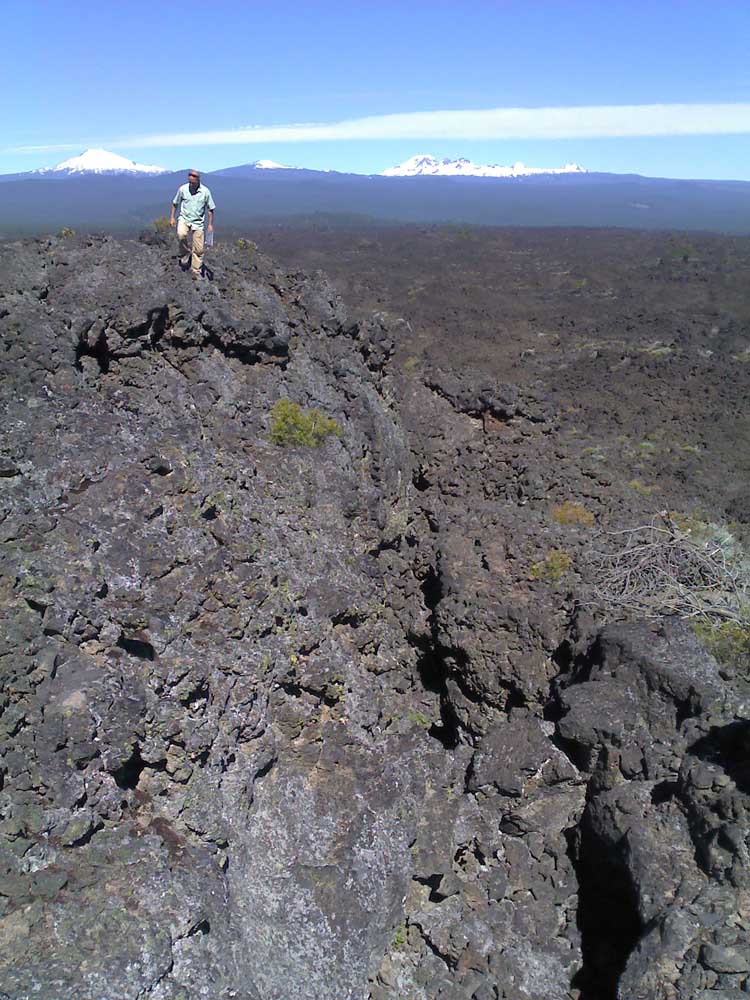OSU-Cascades lab sheds light on unique mammal
Published 12:00 am Tuesday, February 6, 2018

- At left, Matt Shinderman walks along a Lava Butte flow while doing research. He and his team are finding that pikas, a rabbit-like species found in the Western U.S., may be living in the lava flows to keep cool during the summer.(Submitted photo/ Diana Popp)
Hikers and climbers familiar with Central Oregon’s high-elevation areas are likely familiar with the small, rabbit-like animals known as pikas. The famously cute mammals, which require cool temperatures to stay active, have long been thought to be particularly vulnerable to climate change, but new research spearheaded by Oregon State University-Cascades suggests the animals might be thriving in one of the West’s most uncompromising habitats: lava flows.
“This could be a long-term refuge for them,” said Matt Shinderman, director of the Human and Ecosystem Resiliency and Sustainability Lab at OSU-Cascades.
Trending
With support from the National Park Service, the lab, known locally as the HERS lab, acts as a regional hub for monitoring pika activity in lava flows in five areas across the Western United States, including Newberry National Volcanic Monument in Central Oregon.
So far, the research suggests that pikas, once believed to mainly flourish in high-elevation alpine areas, can use cracks in complicated lava flows to hide from predators and keep cool during the hot summer months. Not only does the research help inform future attempts at habitat conservation for pikas, but Shinderman said the project has a chance to become a signature program for OSU-Cascades.
“I think we’re going to build that reputation for sure,” he said.
The American pika, recognizable from rodents due to its round ears and the small piles of plant material it collects, can be found living in boulder piles and rocky slopes on mountains across the Western U.S. The animals do well in environments with lots of snow, but Shinderman said they get less active in temperatures above 78 degrees. In part because of that, pikas have become a poster child for the impact of climate change. Johanna Varner, assistant professor of biology at Colorado Mesa University, said certain pika populations on isolated mountains separated by warmer, low-elevation areas, like those in the Great Basin and in southern Utah, have seen significant declines.
In 2010, the U.S. Fish and Wildlife Service rejected a petition to list the species under the Endangered Species Act, one of several attempts to seek federal protection for the species in the face of rising temperatures.
“What our lab is showing is that there’s quite a bit more nuance to that story,” Shinderman said.
Trending
While pikas are known to reside in lower-elevation areas, Shinderman said the populations were believed to be peripheral until relatively recently. In 2010, Tom Rodhouse, an ecologist with the National Park Service, did a research project looking at low-elevation pika populations, and Shinderman reached out about the possibility of searching for pikas at Newberry.
With help from the National Park Service and the U.S. Forest Service, Shinderman said they discovered “hundreds” of pikas in the lava fields, despite surface temperatures that can reach 120 degrees on hot summer days.
“Those surface temperatures get hostile,” Shinderman said.
However, as anyone who has visited Lava River Cave outside of Bend during the summer can attest, air in cracks and crevasses of lava can be significantly cooler and has a more stable temperature than air on the surface. Rodhouse added that lava flows tend to heat up and cool off much more slowly than the surrounding environment, making it a unique ecosystem to study.
“It’s almost like an ocean, or a big body of water,” Rodhouse said.
For that reason, Shinderman believes that pikas are able to spend hot days inside particularly complex lava formations, shedding their body heat when they travel back below the surface. What’s more, Shinderman said they can elude predators, including weasels, through an elaborate network of cracks in the lava.
Varner observed similar populations of pikas in the Columbia River Gorge, where the lowest-elevation pika population known in the continental United States uses moss on the sides of the gorge as food and to keep cool during warm summer days.
Each spring, Shinderman and other employees of the lab will randomly select 100 units of land across four national areas managed by the National Park Service — Oregon’s Crater Lake National Park, Lava Beds National Monument and Lassen Volcanic National Park in California and Craters of the Moon National Monument in Idaho — to survey for evidence of pikas.
Over the course of two to four weeks during the summer, a field team of four to five people, primarily students, will visit up to 10 sites per day, placing temperature sensors in cracks in the lava. Shinderman added that the lab is experimenting with using cameras that turn on when they detect movement to monitor pikas in the area.
Once the lab starts collecting data, it gets compiled into maps that can be used to determine the likelihood that pikas are living in the area. Diana Popp, project manager for the lab, said the mapping has revealed that pikas prefer more complicated lava flows, which provide additional cracks and overhangs for them to use.
“If there’s not a lot of complexity, there’s not a lot of escape holes for them, and not a lot of cold pockets,” Popp said.
Rodhouse said the HERS lab is the only collaboration between a university and the National Park Service in Oregon east of the Cascades, with the six full-time members of the lab split between employees of the university and the federal agency.
For the park service, the collaboration provides a way to get more data on species living in national parks. Rodhouse said more information could help the agency remove impediments for pika populations, but added that the agency often lacks the manpower, money and habitat to do it on its own.
“This is one of those partnerships that helps advance that goal,” Rodhouse said.
On OSU-Cascades’ end, partnering with a federal agency provides funding, and helps the university attract top-tier students and faculty from outside the region. While the HERS lab is still getting off the ground, Shinderman said the program has attracted students from outside the region, drawn to the opportunity to do work as undergraduates that would be reserved for grad students at larger universities.
Corrinne Oedekerk, an undergraduate student who began working with the lab last summer, will present a poster, with information about her work during the lab, at an annual presentation for the Oregon Chapter of the Wildlife Society in Portland next week.
“It’s really helping to expand the OSU-Cascades brand, which is an important part of the campus growing the way we want it to,” Shinderman added.
— Reporter: 541-617-7818, shamway@bendbulletin.com








